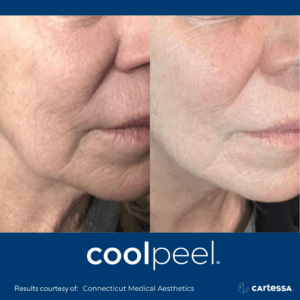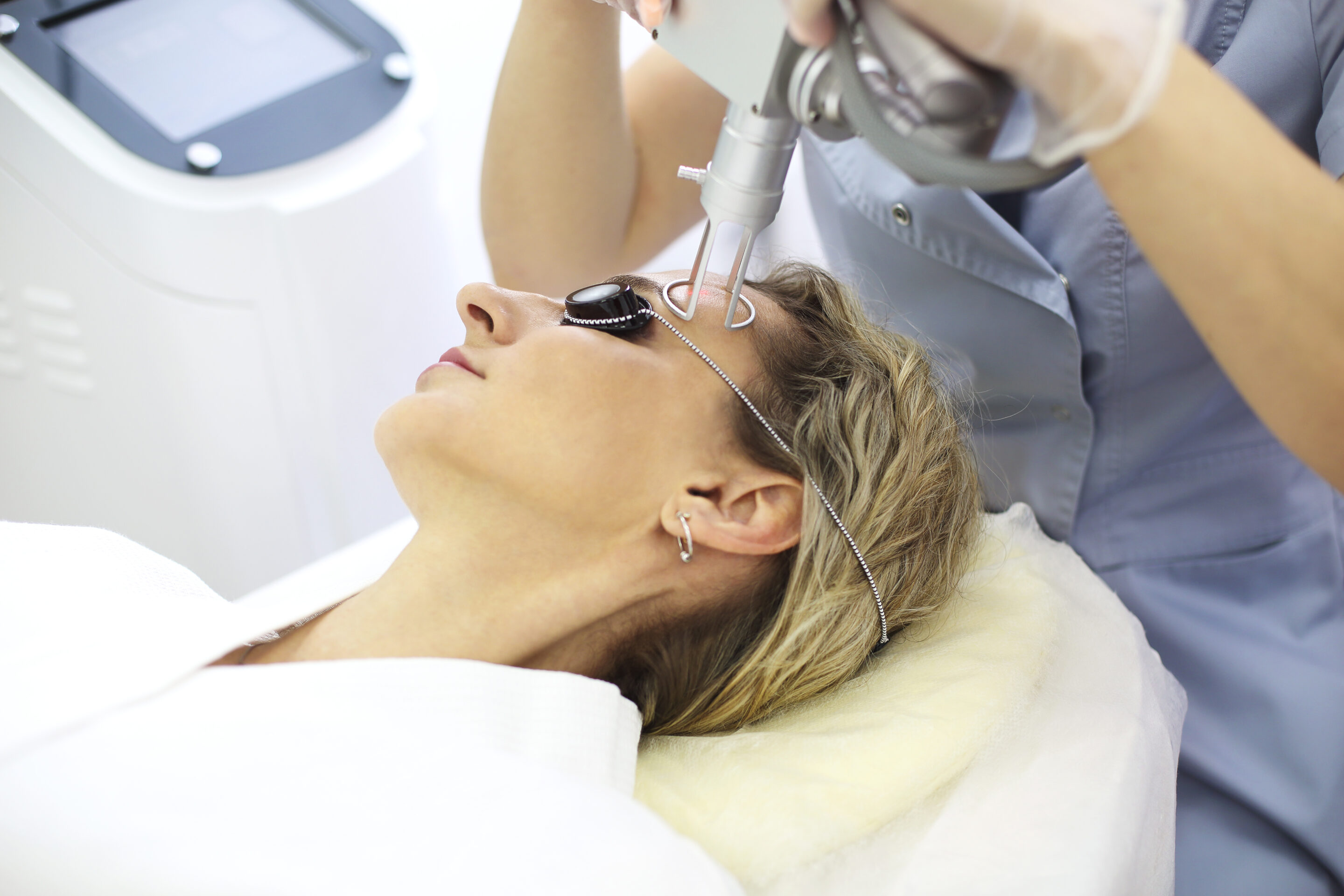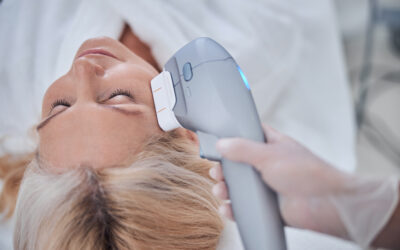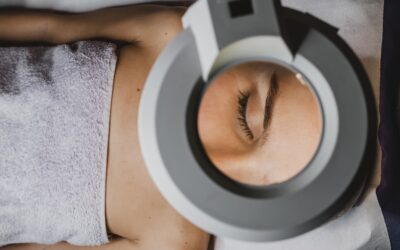Laser Treatment to Tighten Skin is more than just shining a light on your face—it’s advanced science that stimulates collagen for firmer, smoother, younger-looking skin. Understanding exactly how CO2 laser energy remodels the skin helps you choose the right treatment and set realistic expectations.
The Science Behind Laser Treatment to Tighten Skin
Your skin is made up of several layers, but the magic happens in the dermis – the thick middle layer that contains collagen and elastin. Think of collagen as the scaffolding that keeps your skin firm and smooth. As we age, this scaffolding gets damaged and after 25 years old, our body produces less and less of it as we age, leading to sagging and wrinkles.
CO2 laser treatment works by targeting water molecules in your skin cells. When the laser energy hits these water molecules, it creates controlled heat that does two important things immediately.
First, the existing collagen fibers contract and tighten up, kind of like how a shirt shrinks when heated.
Second, the controlled injury signals your body’s repair system to kick into high gear and start creating new, replacement collagen.
Over the next several months, your skin responds to this controlled damage by producing brand new collagen. This new collagen is organized, strong, and plentiful – giving your skin the support structure it needs to look firmer, smoother, and more youthful.
The key word here is “controlled damage.” We’re not burning your skin and waiting for it to flake off; we’re creating precise microscopic injuries that perfectly trigger your body’s natural healing and rebuilding processes for maximum results.
How CO2 Laser Treatment Tightens Loose Skin
When it comes to skin tightening specifically, CO2 laser works on multiple levels. The immediate tightening happens because heat causes the collagen fibers to contract right away. You can see some improvement immediately after treatment, though your skin will be red and swollen.
The real transformation happens over the following months. The laser creates thousands of microscopic columns of treated tissue that go deep into the dermis. Your body recognizes these areas as needing repair and floods them with healing factors and new collagen production.
This new collagen forms in a more organized pattern than the damaged collagen it’s replacing. It’s stronger, more elastic, and provides better structural support. As this new collagen matures over 3-6 months, your skin gradually becomes firmer and more lifted.
The depth of treatment is crucial here. Surface treatments can’t reach the structural layers where tightening occurs. CO2 laser penetrates deep enough to remodel the skin’s support structure, which is why it provides more dramatic and longer-lasting results than other types of laser treatments.

co2 laser
How CO2 Laser Softens and Reduces Scars
Scars form when your body repairs damaged skin with disorganized collagen that doesn’t match the surrounding tissue. This collagen is often thicker, less flexible, and has a different texture than normal skin. CO2 laser treatment addresses scars by essentially giving your body a “do-over” at the repair process.
The laser breaks down the old, disorganized scar tissue and stimulates new collagen production in its place. This new collagen forms in a more normal pattern that better matches your surrounding skin. The process also helps normalize the blood flow to the area and reduces the thick, rope-like collagen bundles that make scars feel hard and raised.
For acne scars specifically, the laser can help both raised and depressed scars. For raised scars, it breaks down excess collagen. For depressed scars, it stimulates new collagen production to fill in the depression. The controlled injury also helps smooth the edges of scars, making them blend better with surrounding skin.
The improvement in scars happens gradually as the new collagen forms and matures. Most people see continued improvement for up to a year after treatment as the remodeling process continues.
How CO2 Laser Improves Stretch Marks
Stretch marks are essentially scars that form when skin is stretched beyond its elastic capacity. The collagen and elastin fibers break, leaving behind those characteristic lines. CO2 laser treatment can significantly improve stretch marks, though the results depend on their age and severity.
The laser works by breaking down the damaged collagen in the stretch marks and stimulating new, healthy collagen production. This process helps restore some of the skin’s normal texture and elasticity. The treatment also improves blood flow to the area, which helps with the overall healing and remodeling process.
Newer stretch marks that are still red or purple tend to respond better than older, white stretch marks, but even older stretch marks can show improvement. The laser helps normalize the skin texture and can reduce the depth and width of the marks significantly.
The key is that we’re essentially restarting the healing process in these areas with the goal of producing better-quality collagen than what formed initially. Multiple treatments are often needed for stretch marks because we’re working to rebuild the entire structure of the affected skin.
How CO2 Laser Improves Overall Skin Tone (Pigmentation and Redness)
Uneven skin tone comes from several factors including sun damage, age spots, melasma, and general skin aging. CO2 laser addresses these issues by removing damaged surface skin and stimulating renewal from deeper layers.
The laser treatment removes the top layers of skin that contain most of the pigment irregularities. As your skin heals, new skin cells come to the surface from deeper layers that haven’t been as damaged by sun exposure or aging. This creates a more even, uniform appearance.
The treatment also stimulates increased cell turnover, which means your skin continuously brings fresh, undamaged cells to the surface. The new collagen production improves overall skin quality, making it more reflective and giving it a healthy glow.
Additionally, the improved blood flow and cellular activity that comes with healing helps normalize pigment production and distribution. This is why people often say their skin looks “brighter” or more “radiant” after CO2 laser treatment.
Why Deka CO2 Technology Is Different
Traditional, older CO2 lasers created continuous vertical only zones of treated tissue, which meant more trauma, longer healing times, and higher risk of side effects.
The Deka CO2 system uses advanced fractional technology with a unique zig-zag scanning pattern into the skin that changes everything.
Instead of treating skin in straight lines or grids, the Deka system creates a random, overlapping pattern of microscopic treatment zones. This zig-zag approach leaves much more healthy tissue between the treated areas, which dramatically speeds healing and reduces downtime.
The pattern also means less oozing and bleeding during recovery because the healthy tissue bridges help maintain the skin’s barrier function. Your skin can heal from multiple directions instead of having large continuous areas that need to repair themselves.
This technology also allows for much more precise control over treatment depth and density. We can adjust exactly how deep the laser penetrates and how much of your skin surface we treat, allowing for customized treatments that match your specific concerns and healing capacity.
The Deka system’s versatility means we can provide anything from very gentle “lunch break” treatments to more intensive resurfacing, all with the same device. This precision leads to better results with less risk and shorter recovery times.
The Timeline of Skin Transformation
Understanding the timeline helps set realistic expectations for your laser treatment to tighten skin. Immediately after treatment, you’ll see some tightening from collagen contraction, but your skin will also be red and swollen.
During the first week, your skin goes through the healing phase where the treated tissue is replaced by new skin. This is when you might experience peeling or flaking skin – this is completely normal and shows the treatment is working.
Weeks 2-4 are when you start to see real improvements in skin texture and tone. The new surface skin has formed, and early collagen production is beginning. Your skin will look smoother, more glowing and more even toned.
Months 2-6 are when the dramatic improvements in skin tightening occur. This is when the new collagen is forming and organizing itself. You’ll notice progressive improvement in firmness and elasticity during this time.
The final results are typically visible around 6-9 months, though some continued improvement can occur for up to a year as the collagen continues to mature and remodel.
Making Laser Treatment Work Best for You
The key to getting optimal results from laser treatment to tighten skin is working with someone who understands both the science and the artistry involved. The laser settings, treatment pattern, and post-care instructions all need to be tailored to your specific skin type and concerns.
Proper preparation before treatment and diligent aftercare are crucial for both safety and results. Your skin needs the right nutrients and protection to heal optimally and produce the best quality collagen.
Understanding how the science works helps you make informed decisions about your treatment plan and gives you realistic expectations about the timeline and results you can expect.
The technology continues to evolve, making laser treatment to tighten skin safer and more effective than ever before. When you understand the science behind how it works, you can feel confident about the remarkable transformation that’s happening beneath the surface of your skin.




